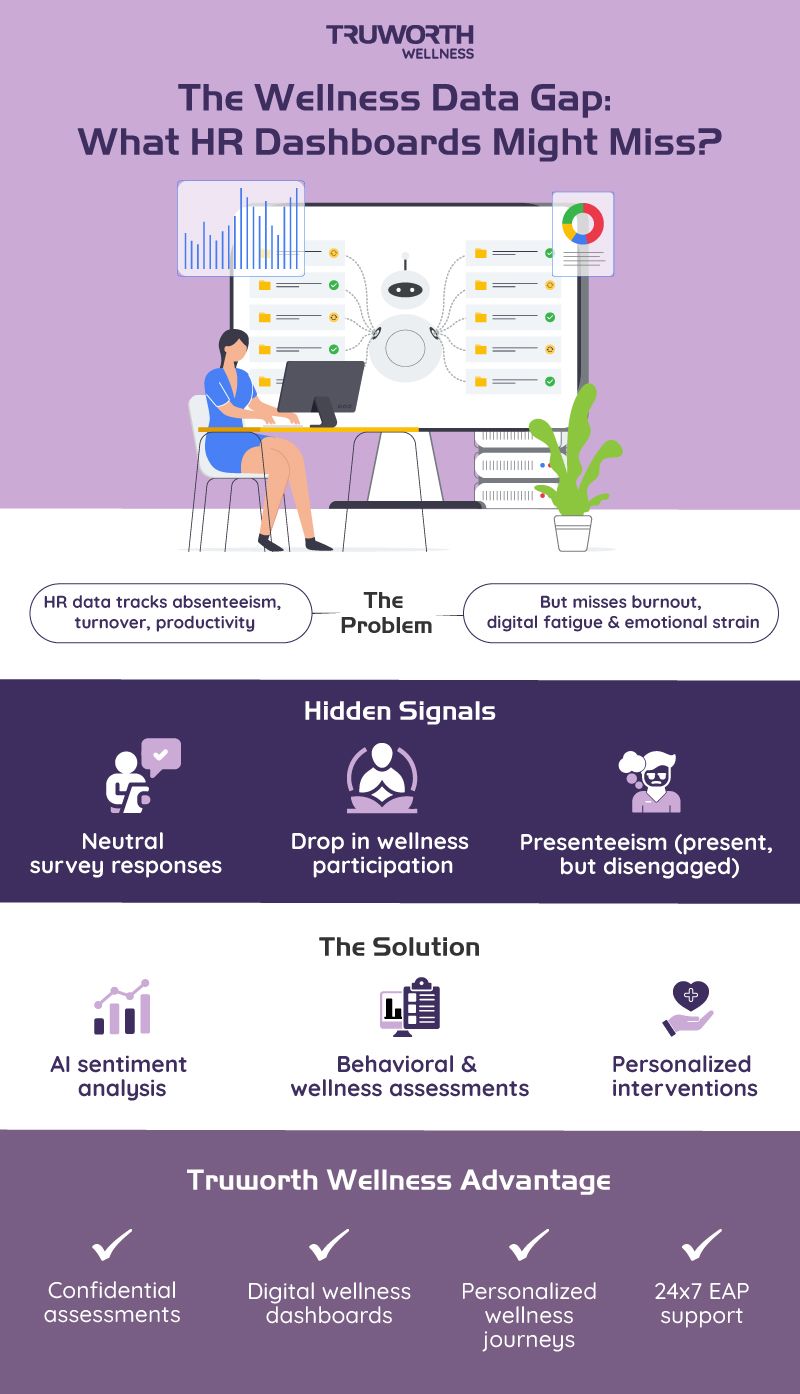The Wellness Data Gap: What Your HR Dashboards Aren’t Telling You?

Your HR dashboard might show all systems go: low absenteeism, stable retention, decent engagement scores. But talk to your employees, and another narrative may emerge—one filled with fatigue, disconnection, and quiet burnout.
This is the wellness data gap: the blind spot in traditional HR metrics where emotional well-being, digital exhaustion, and mental health struggles often remain hidden.

Why Traditional HR Dashboards Are Falling Short?
Human Resource Information Systems (HRIS) were built for a time when productivity, attendance, and turnover were considered the gold standard of workforce health. While these metrics still hold value, they don’t paint the full picture, especially in a post-pandemic world where mental and emotional strain is an everyday realities.
Here's what your dashboard might be missing:
- Emotional fatigue: Chronic stress, decision fatigue, and empathy burnout among both employees and managers.
- Digital exhaustion: The toll of endless video calls, messages, and screen time with no boundaries.
- Quiet burnout: A creeping disengagement where employees continue to deliver, but with minimal emotional investment.
These hidden stressors don’t always trigger an immediate dip in performance. Instead, they build silently until one day, a valued employee resigns, team morale tanks, or productivity suddenly slumps.
The Invisible Symptoms You Should Be Watching For
The wellness data gap doesn’t mean the signs aren’t there—it just means you’re not measuring them properly.
Here are subtle indicators that may suggest trouble brewing beneath the surface:
- Neutral survey responses: If a significant portion of your team is selecting “neutral” on engagement questions, that’s not indifference—it’s emotional distancing.
- Decreased participation in wellness programs: Disinterest in previously popular initiatives can signal emotional fatigue.
- Change in communication patterns: A drop in spontaneous interactions or collaboration may reflect social withdrawal.
- Micro-absenteeism: Frequent half-days, late logins, or extended breaks that don’t qualify as absenteeism but point to disengagement.
- Increased “presenteeism”: Employees are present but mentally checked out, often going unnoticed in performance reviews.
These quiet signals can slip under the radar unless organizations start collecting and interpreting data differently.
The Role of Emerging Tech in Bridging the Gap
Thankfully, the landscape is evolving. Today’s wellness tech platforms go beyond counting steps or tracking physical health. They integrate AI, behavioral science, and mental health indicators to create a holistic picture of employee well-being.
Here’s what’s changing:
- AI-Powered Sentiment Analysis: Modern tools can analyze survey responses, internal chat platforms (with consent), and feedback to pick up on emotional tones, stress indicators, and burnout risk, long before traditional metrics catch on.
- Behavioral Analytics: Some platforms offer digital wellness dashboards that highlight excessive screen time, meeting overload, or a lack of breaks—all contributors to digital fatigue.
- Predictive Wellbeing Models: By analyzing patterns such as engagement dips, communication habits, and wellness activity usage, platforms can flag potential burnout risks, providing actionable insights for HR.
- Personalized Interventions: Rather than sending out generic wellness newsletters, tech enables targeted nudges, such as a mindfulness prompt to someone showing signs of stress or recommending a counseling session proactively.
The goal isn’t to track more—it’s to track better, with consent, purpose, and empathy at the core.
The Ethics of Employee Wellness Data: A Double-Edged Sword
With greater insight comes greater ethical responsibility. When organizations begin analyzing behavioral or emotional data, they must be cautious not to cross the line from support to surveillance.
Some critical ethical considerations include:
- Informed Consent: Employees should know what’s being tracked, how it’s being used, and should always have the option to opt out.
- Transparency: Be open about the goals of wellness analytics. Clarify that data will be used to improve support, not to monitor performance or penalize individuals.
- Data Anonymization: Platforms should allow aggregate reporting rather than individual tracking, unless an employee actively opts in for one-on-one wellness coaching.
- Psychological Safety: Knowing they’re being "watched" can be stressful for employees unless HR leaders establish a culture of trust and open communication.
Ethical wellness data is not about controlling employees—it’s about understanding them better so we can help them thrive.
Also Read: HR Steps To Prevent Work Burnout In Employees
Actionable Steps HR Leaders Can Take Today
You don’t need a massive tech overhaul to begin bridging the wellness data gap. Start small but intentionally:
1. Redefine Your KPIs
Incorporate soft metrics like participation in mental health programs, self-reported wellness scores, and engagement with EAP resources. Even small data points, tracked consistently, can reveal trends.
2. Train Managers to Spot Burnout
Equip team leaders to recognize the early signs of burnout and digital exhaustion—not just through performance, but through behavior, tone, and team dynamics.
3. Audit Your Digital Culture
Do your employees have meeting-free hours? Are they expected to respond after hours? A culture audit can help identify invisible pressures that contribute to burnout.
4. Normalize Conversations Around Mental Health
Encourage leaders to check in on well-being, not just work. Create forums where mental health isn’t taboo but a priority.
5. Choose Wellness Tech with Integrity
Partner with platforms that embed ethical data practices, offer personalized support, and promote long-term wellness, not just quick fixes.
Also Read: How To Bounce Back After Burnout At The Workplace?
How Truworth Wellness Helps Close the Gap?
At Truworth Wellness, we understand that traditional wellness models often fall short in today’s hyper-connected, high-stress work environment. Our holistic employee wellness platform bridges the gap by combining:
- Mental health tools, including 24x7 access to EAP counselors
- Digital wellness dashboards that identify burnout risks early
- Personalized wellness journeys tailored to individual needs
- Privacy-first design, ensuring employees feel safe, not monitored
- Assessments that help uncover stress, burnout, and emotional fatigue before they escalate
We believe that better wellness data—used responsibly—can transform not just employee health, but the entire work culture.
Final Thoughts
The wellness data gap isn’t just a technical issue—it’s a human one. As the nature of work continues to evolve, so must the way we understand, support, and care for the people who make it all happen.
It’s time to stop assuming everything’s fine because the dashboard says so. Let’s dig deeper, act sooner, and build a more human-centric approach to employee well-being.
Want to know where your wellness data is falling short—and what to do about it?
Let’s talk. Discover how Truworth Wellness can help you decode hidden burnout and foster a thriving workplace. Get in touch today.